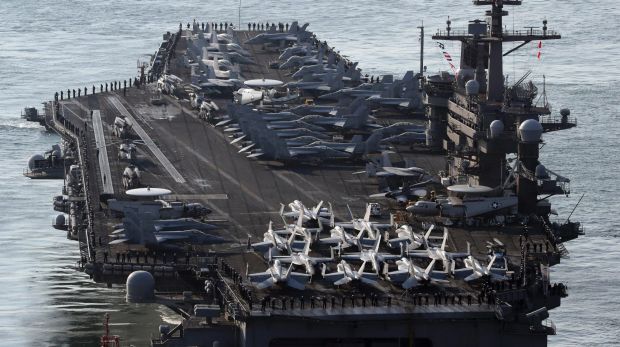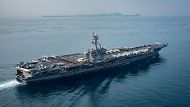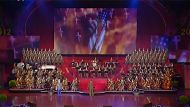Beijing: As tensions mounted on the Korean Peninsula, Admiral Harry Harris made a dramatic announcement: an aircraft carrier had been ordered to sail north from Singapore towards the Western Pacific on April 8.
In reality, it was on its way to join Australian forces in the Indian Ocean.
More World News Videos
USS Carl Vinson hasn't left for North Korea
US President Donald Trump said an aircraft carrier was heading to North Korea, but a US Navy photo showed the warship was not heading in that direction.
Nevertheless, a spokesman for the Pacific Command linked the deployment directly to the "number one threat in the region", North Korea, and its "reckless, irresponsible and destabilising program of missile tests and pursuit of a nuclear weapons capability".
Defence Secretary James Mattis told reporters on April 11 that the USS Carl Vinson was "on her way up there".
Asked about the deployment in an interview with Fox Business Network that aired on April 12, President Donald Trump said: "We are sending an armada, very powerful."
The US media went into overdrive and Fox reported on April 14 that the armada was "steaming" towards North Korea.
But a photograph released by the US Navy showed the aircraft carrier sailing through the calm waters of Sunda Strait between the Indonesian islands of Sumatra and Java on Saturday, April 15.
In other words, on the same day the world nervously watched North Korea stage a massive military parade to celebrate the birthday of the nation's founder Kim Il-sung, and the press speculated about a pre-emptive US strike, the US Navy put the Carl Vinson, together with its escort of two guided-missile destroyers and a cruiser, more than 4800 kilometres south-west of the Korean peninsula and more than 800 kilometres south-east of Singapore.

Instead of steaming towards the Korea Peninsula, the carrier strike group was actually headed in the opposite direction to take part in "scheduled exercises with Australian forces in the Indian Ocean", according to Defence News, which broke the story.
Neither Pacific Command nor the Pacific Fleet responded to requests for comment.

On Monday, Pacific Fleet spokesman Commander Clayton Doss said only that the USS Carl Vinson and its escorts were "transiting the Western Pacific", declining to give a more precise location except to rule out the waters around South Korea or Japan.
The presence of the US carrier strike group, and the threat of a US military strike on North Korea, had weighed heavily on Chinese minds and in the media there. Foreign Minister Wang Yi warned that "storm clouds" were gathering and the risk of conflict was rising.

The news that the ships weren't where everyone assumed them to be was greeted with some glee in the Chinese media on Tuesday.
"Tricked badly!" the Global Times exulted on its social media account. "None of the US aircraft carriers that South Korea is desperately waiting for has come!"
Was it all a misunderstanding, or deliberate obfuscation?
Cai Jian, an expert from the Centre for Korean Studies at Fudan University in Shanghai, said the whole episode was part of an elaborate game of "psychological warfare or bluffing" by the United States, arguing that Washington never really intended to launch a military strike on North Korea right now.
"At the peak of the stand-off, psychological warfare is very important," he said.
Ross Babbage, a non-resident senior fellow at the Centre for Strategic Budgetary Assessments, a Washington-based think tank that focuses on the military, said the move might be "military signalling" from the US
"It's more than a bluff," he said. "A bluff suggests you're not serious. My understanding is that this US administration is dead serious; it's been 40 years of trying to get the North Koreans to back away from the nuclear weapons."
Babbage said it was also possible the United States administration had decided to give China a little time to put its own pressure on North Korea before sending the carrier strike group north: Trump met his Chinese counterpart Xi Jinping on April 6 and 7 and spoke by phone on April 11, and may have wanted to give the Chinese some breathing space before "rattling the bars", Babbage said.
Nor should the aircraft carrier's presence, alone, be given too much weight, he added, since any early strikes on North Korea would most likely have been carried out by long-range aircraft.
While the belief that the Carl Vinson was heading towards the Korean Peninsula was reported as fact by media outlets around the world, there were hints it was perhaps not steaming there as fast as many supposed.
On April 11, USNI News reported that, although the carrier had cancelled port calls in Australia, it had not cancelled training events to move faster towards the Korean Peninsula, and would still take more than a week to enter waters near Korea - a point that was lost amid heated talk of war.
In any case, the carrier strike force may indeed be finally heading north now.
The Korea Herald reported on Monday that the USS Carl Vinson is due to arrive in South Korea's eastern waters on April 25, in time for another important date in the North Korean calendar: the anniversary of the army's foundation.
Quoting unnamed South Korean officials, the Herald said: "The strike group will join the South Korean Navy in a massive maritime drill designed to counter provocation from the North."
CNN also cited US defence officials as saying the aircraft carrier will arrive off the Korean Peninsula at the end of April.
The Washington Post













90 comments
New User? Sign up